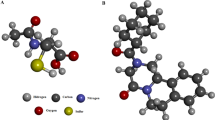Abstract
The present study tested the hypothesis that mice exposed to Schistosoma mansoni and treated with the insecticide Larvin have an increased risk of accelerated liver damage. To investigate this hypothesis, adverse effects resulting from treatment with Larvin were compared between S. mansoni-exposed and nonexposed outbred albino mice. The effects of concurrent treatment with Larvin on the progress and outcomes of S. mansoni infection were assessed via macroscopic and microscopic examination of liver and spleen, evaluation of several hematological, biochemical and hepatic enzymes parameters, and effect on worm burden. Oral administration of 1/5 and 1/10 LD50 of Larvin to S. mansoni-exposed mice induced (1) hepatomegaly and splenomegaly; (2) prominent lymphocytic aggregation in liver replacing large areas of bridging necrosis; (3) increased serum level of bilirubin and alanine aminotransferase–aspartate aminotransferase enzymes; (4) decreased serum level of albumin and total proteins; and (5) decreased RBC, hemoglobin content, leukocyte, and lymphocyte counts. No significant effect on worm burden or oviposition was noted as a result of Larvin treatment compared to controls. All doses used in mice either for infection with S. mansoni cercariae or treatment with Larvin resulted in dose dependent alterations in hepatic functions of the tested mice. These alterations were most profound in mice exposed to S. mansoni and receiving Larvin treatment. The present findings support our hypothesis and show that concurrent S. mansoni infection with exposure to Larvin adversely affect liver functions and seriously alter hematological, biochemical, and hepatic enzymes parameters in outbred albino mice. These findings warrant further investigation and reinforce the need to minimize exposure to insecticide in both natural field settings and the broader environment.


Similar content being viewed by others
References
Allen JL, Gonzales F, Boyne JV (1989) Larvin brand thiodicarb insecticide. A new carbamate insecticide. Mededelingen-van-de-Faculteit Landbouwwetenschappen, Rijksuniversiteit-Gent 36:1167–1171
Amr MM, Omar MM, Hameida NA, El-Tarras A, Abou Ahmed MM, Ali UA (1995) Genetic toxicity of th epesticides Hostathion, Sumithion and Dithane M-45 in mice. Abstract at 3rd Congress of Toxicology in Developing countries, Cairo, Egypt
Attallah AM, Abbas AT, Dessouky MI, El-Emshaty HM, Elsheikha HM (2006) Susceptibility of neonate mice born to Schistosoma mansoni-infected and noninfected mothers to subsequent S. mansoni infection. Parasitol Res 99:137–145
Bruce JI, Radke MG (1971) Culturing Biomphalaria and Oncomelania (Gastropoda) for large scale study of schistosomiasis: I. Cultivation of Biomphalaria glabrata and maintenance of S. mansoni in the laboratory. Bio Med Rep 406th Med
Capron A, Dessaint JP, Capran M, Ouma JH, Butterworth AE (1987) Immunity to schistosoma progress towards vaccine. J Sci 238:1065–1072
Crowley LV (1967) The Reitman-Frankel colorimetric transaminase procedure in suspected myocardial infarction. Clin Chem 13:482–487
Dunn MA, Kamel RK (1981) Hepatic schistosomiasis. Hepatology 1:6
Eid M, Nour A, AlBadry K (1995) Experimental study of S. mansoni from Yamen. International conference on schistosomiasis, Cairo, Egypt
El-Kashory AA (1984) Toxicological effects of certain pesticides on internal organs and metabolism of rats. MS Thesis. Faculty of Agriculture, Ain Shams University, Cairo
Ghanem MH, Guirgis FK, Elsawy M (1970) Serum and ascetic fluid magnesium in bilharzial (schistosomal) Hepatic Fibrosis. Amer J Trop Med Hyg 73:237–239
Gold SR, Heyneman D (1989) Life cycle of S. mansoni. Tropical Medicine and Parasitology. Ch. 21. Appleton and Lange, New York, p 434
Hanna LS, Medhat AM, Abdel-Menem HA (2003a) Biochemical changes after subchronic and chronic interaction of Schistosoma mansoni infection in Swiss albino mice with two specific compounds. J Egypt Soc Parasitol 33:245–260
Hanna LS, Medhat AM, Abdel-Menem HA (2003b) Effect of diazinon and/or praziquantel on selected protein aspects in healthy and Schistosoma mansoni infected mice. J Egypt Soc Parasitol 33:145–162
Hesse M, Piccirillo CA, Belkaid Y, Prufer J, Mentink-Kane M, Leusink M, Cheever AW, Shevach EM, Wynn TA (2004) The pathogenesis of schistosomiasis is controlled by cooperating IL-10-producing innate effector and regulatory T cells. J Immunol 172:3157–3166
Kostaka G, Pault D, Kopec-Szlezak J (1994) Early hepatic changes induced by muarimol in rats. J Appl Toxicol 14:337–342
Litchfield JT, Wilcoxon T (1949) A simplified method of evaluating dose effect experiments. J Pharmacol Exp Ther 96:99–113
Parent-Massin D, Thouvent D (1993) In vitro study of pesticide hematoxicity in human rat progenitors. J Pharmacol Toxicol Methods 30:203–207
Pellegrino J, Oliveira CA, Faria J, Cunha AS (1962) New approach to the screening of drug in experimental schistosomiasis mansoni in mice. Am J Trop Med Hyg 11:201–215
Phillips SM, Fox EF (1982) The immunopathology of parasitic disease. Clin Immunol Allergy 24:183–186
Sheffield SR, Lochmiller RL (2001) Effects of field exposure to diazinon on small mammals inhabiting a semienclosed prairie grassland ecosystem. I. Ecological and reproductive effects. Environ Toxicol Chem 20:284–296
Smithers SR, Terry RJ (1965) The infection of Laboratory hosts with cercariae of Schistosoma mansoni and the recovery of adult worms. Parasitology 55:695–700
Warren KS (1982) The effect of immunopathogenesis of schistosomiasis: in vivo models. Immunol Rev 61:189–192
World Health Organization (1991) Tropical diseases progress in research. World Health Organization, Geneva, pp 41–51
Acknowledgements
The authors wish to thank the editor and reviewers of Parasitology Research for their constructive comments that have led to this improved version of the manuscript. Authors declare that the experiments comply with the current laws of Egypt.
Author information
Authors and Affiliations
Corresponding author
Rights and permissions
About this article
Cite this article
Attallah, A.M., Wahba, M.A., Elsheikha, H.M. et al. Outcomes of Schistosoma mansoni infection in outbred albino mice exposed to Larvin contaminant. Parasitol Res 103, 567–576 (2008). https://doi.org/10.1007/s00436-008-1011-7
Received:
Accepted:
Published:
Issue Date:
DOI: https://doi.org/10.1007/s00436-008-1011-7




